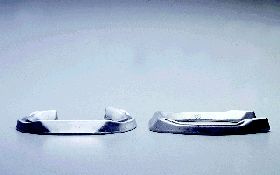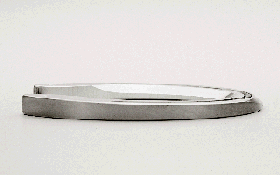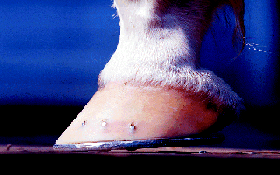The Roller Motion Shoe
by Walt Koepisch • photos by Keith Sutter
published in ANVIL Magazine, December, 1998
 |
 |
Roller Motion Aluminum shoes from Dutchtown Forge |
The ELITE Inner Rim shoe from the Victory Racing Plate Company |
 |
 |
The World Plate by Thoro'Bred, Inc. |
The K-B Performance shoe by G.E. Forge & Tool |
The primary interest in shoe design revolves around horses being more fluid movers; i.e., maximizing their inherent potential. The design of a shoe influences how this individual horse will move. Support, flotation, angle — ground contact and breakover, the movement of the foot — even the comfort level of the shoe will be an important influence on how well the horse will perform.
In order for a horse to move well, it naturally must be trimmed in balance, in respect to its feet and overall conformation. When trimming fails to help the horse move clean, then one must look to the shoe to obtain the balance desired. Specialized shoes may be wide-webbed aluminum to add flotation (maintaining the foot on the working surface), side weight or side support (lateral or medial support). Or one can use a wedge shoe to either restore lost hoof angle or to increase existing ground surface available to the horse.
A new solution can be found in a factory-manufactured roller-motion shoe,
which allows the foot to break over sooner than would normally be expected.
By giving the break (over) a head start, the horse does not experience the
sudden, sometimes severe break (over) of a normal or square-toed shoe. Such
hitches, anywhere in a horse’s stride, will affect the fluid nature of the
animal’s gait. To visualize this concept, consider that all aspects of a
horse’s movement are the spokes of a large wagon wheel. If all the spokes
are the same length, the wheel will roll smoothly — if one or more are
too short or overly long, then the wheel has no hope of running in a smooth
or fluid fashion.
 |
 |
This hoof was shod with a flat steel keg shoe, showing the breakover at the tip of the toe. |
|
A fluid-moving horse uses his shoulders. Whether hunters or Western pleasure horses jog or trot, the stride should be long, fluid and graceful; a slow cadence is a must, with the horse displaying a lot of reach with its front legs. Many horses do not fit this mold, especially if they are not using their shoulders or are, in effect, victims of their own conformation. It may also be that the horse is not using its hind quarters to full potential, resulting in a shorter stride and a much faster cadence.
The roller motion shoe can help these horses by allowing the break (over)
to start sooner, but slower. It eases the effort it takes to break (over)
and thus gets the foot and leg more in front of the horse, rather than behind
him. Squaring the toe will quicken the break (over), but the break is done
abruptly, losing the fluid action sought. The influence of the shoe can also
be increased by rolling the toe, so the actual amount needed for a particular
horse can be adjusted to its particular needs.
 |
 |
This hoof was shod with a slight rocker toe showing the breakover set back from the toe |
|
Videotapes of horses trotting will often show a horse landing toe first. A horse with reach and a fluid stride will land flat — or, basically, heel first. If the horse is landing toe first, it is not driving with the hind quarters or is stiff in the ankles or shoulders. In either case, the stride is not as long as it could possibly be. A roller motion shoe will help give a little more movement to the ankle and make up for a sore shoulder, encouraging a more fluid and longer stride.
The roller motion shoe should not be considered as a tool for only the front feet. Hind foot applications help the horse to work with his hocks completely under him, instead of behind him. A fluid-moving horse will have to shift some extra weight to the hind end in order to free up or compensate on the front legs. If the hind legs are not freed up, or compromised by break (over) problems, they end up stuck on the ground, effectively negating any extension of the front legs.
Everything is tied together and motion begins from the hind legs. Remember: a horse is a push animal, not a pull animal.